Expressive arts are accessible to everyone regardless of physical abilities. You’ll find adaptive tools like easy-grip brushes and wheelchair-accessible tables that support creative expression. Movement-based programs like “Dance Beyond Wheels” celebrate diverse mobility, while digital platforms offer touch-free interactions for those with limited dexterity. Art therapy provides emotional release, reduces stress, and builds self-confidence for participants. Discover how inclusive art communities are transforming lives through creativity tailored to all body types and capabilities.
Embracing Creativity Beyond Physical Limitations
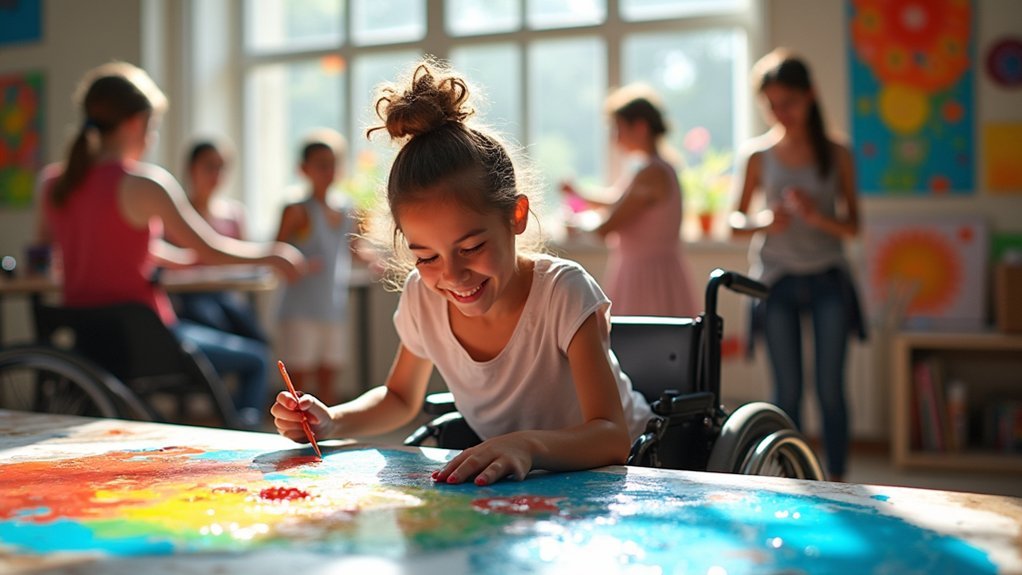
While traditional artistic expression often seems contingent on specific physical capabilities, the true essence of creativity transcends bodily limitations.
You’ll find that expressive arts offer powerful pathways for communication beyond physical constraints, providing therapeutic benefits that adapt to diverse abilities.
When you engage in creative activities, you’re not just making art—you’re developing cognitive skills, enhancing emotional expression, and building community connections.
Art therapy helps reduce stress and anxiety while boosting your self-esteem, regardless of physical ability.
Art therapy transcends physical limitations, offering emotional relief and confidence-building through creative expression.
With adapted programs and accessibility tools, you can participate in multidisciplinary approaches that cater to your unique learning style.
These programs foster neuroplasticity and emotional intelligence while improving social integration.
You’re not defined by physical limitations when creative expression becomes the language through which you connect with yourself and others.
Research shows that regular involvement in arts-inclusive programs can significantly improve children’s wellbeing, with the World Health Organization recommending at least 2 hours of arts engagement per week for optimal mental health benefits.
Adaptive Art Tools That Empower Expression
When creativity calls, your body’s limitations shouldn’t stand in the way of artistic expression. Easy-grip tools and thick-handled brushes support those with limited hand strength, while adaptive grips can transform standard art supplies into accessible instruments.
You’ll find ergonomic and weighted options provide stability for tremors, while modified utensils taped to fingers accommodate severe hand limitations. Wheelchair-accessible tables guarantee proper positioning for mobility needs.
Consider exploring textured materials and scented paints that engage multiple senses. Organizations like Zot Artz offer specialized equipment that transforms wheelchairs into painting devices for large-scale projects. These activities promote an inclusive environment where children of all abilities can participate in stamping, drawing, and printing.
The benefits extend beyond art itself—these tools foster motor skill development, improve concentration, and boost self-esteem while encouraging self-expression regardless of physical ability.
Movement-Based Arts for Wheelchair Users
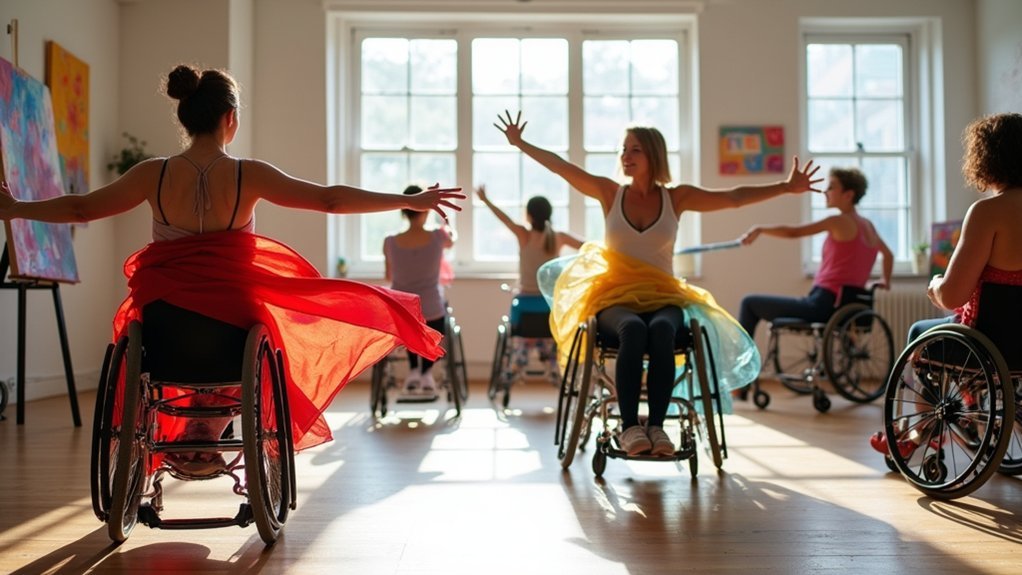
Movement-based arts offer wheelchair users innovative ways to express themselves through techniques like Dance Beyond Wheels, where you’ll discover performance possibilities both in and out of your chair.
You can explore Fluid Expression Techniques that adapt to your unique mobility, creating compelling performances that challenge traditional dance dynamics. These approaches help counter the fact that ninety-five percent of disabled characters are portrayed by able-bodied actors in mainstream performing arts.
Adapted Movement Therapy combines artistic expression with physical benefits, allowing you to improve strength and coordination while developing your creative voice.
Dance Beyond Wheels
Historically relegated to the sidelines, movement-based arts for wheelchair users have emerged as a vibrant, transformative field that challenges traditional notions of dance.
“Dance Beyond Wheels” encompasses innovative approaches that integrate wheelchair mobility with artistic expression, creating entirely new movement vocabularies and aesthetic possibilities.
You’ll find more collegiate programs embracing wheelchair dancers, though architectural and attitudinal barriers remain.
These initiatives not only enhance motor skills but empower participants through meaningful social interaction and self-expression.
Professional wheelchair dancers continue gaining recognition, reshaping public perception of ability in performance art. Faculty often exhibit internalized ableism when evaluating the potential of disabled dancers, limiting their educational opportunities and career pathways.
Digital platforms now offer accessible classes, while specialized software bridges participation gaps.
Through mixed-ability partnerships and community engagement, wheelchair dance fosters mutual understanding while developing innovative teaching methods that address historical exclusion from movement-based arts.
Fluid Expression Techniques
Evolving beyond traditional boundaries, Fluid Expression Techniques have revolutionized movement-based arts for wheelchair users through adaptable approaches that celebrate diverse body abilities.
You’ll find these methods focus on personalized expression rather than standardized movements.
When you participate in these programs, you’re entering inclusive spaces where your unique movement capabilities become artistic strengths. Similar to how fluid cushions provide personalized pressure management through immersion and envelopment, these techniques allow your body to find its natural artistic flow. Adaptive equipment and digital tools enhance your range of motion, while sensory integration elevates your creative experience.
You’ll tell stories through movement, building confidence as you express emotions that might otherwise remain unspoken.
These techniques thrive in various settings—from community centers to therapeutic environments—making artistic expression accessible regardless of mobility.
Through collaborative learning, you’ll connect with others while discovering new forms of self-expression that transcend physical limitations.
Adapted Movement Therapy
While traditional movement therapies often overlook wheelchair users, Adapted Movement Therapy transforms this landscape by merging artistic expression with specialized physical activities tailored to diverse mobility needs.
You’ll discover customized equipment like adaptive rowers and arm cranks designed with accessibility and usability in mind.
Wheelchair dance stands out as a powerful therapeutic modality, enhancing your maneuvering skills while fostering creative expression. These movement-based arts don’t just improve your physical health—they’re proven to boost your emotional wellbeing and quality of life scores.
The most effective programs blend physical therapy, adapted sports, and expressive arts while personalizing activities to your unique abilities. Participants consistently report that having multiple adapted options empowers them with greater agency in their exercise choices.
Through regular participation in community settings, you’ll experience benefits across physical, emotional, interpersonal, and material wellbeing domains.
Sensory Art Experiences for Diverse Cognitive Abilities
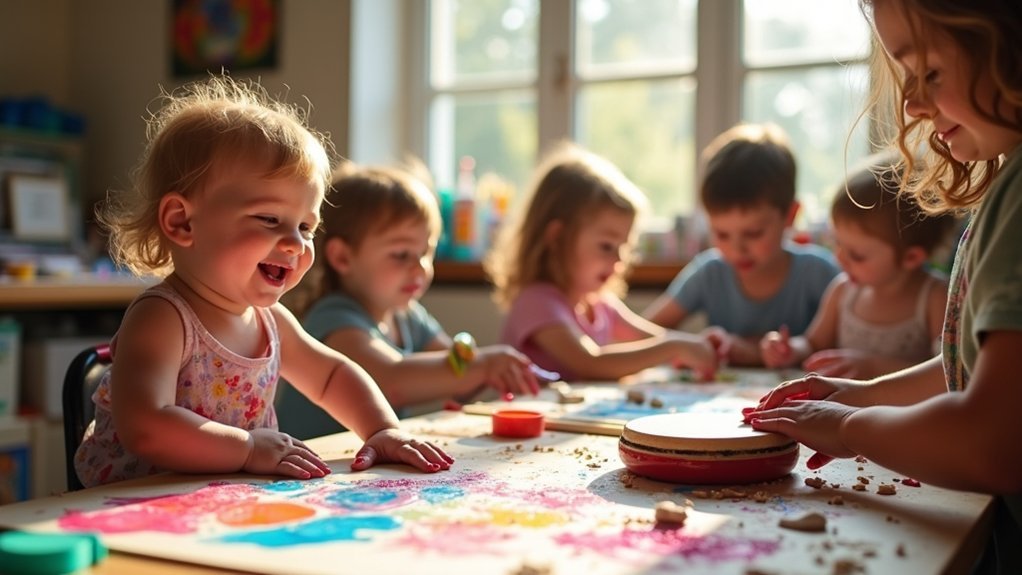
How can art become more than just a visual experience? When you engage with sensory art, you’re activating multiple brain regions simultaneously, enhancing neuroplasticity and emotional regulation. These practices serve as powerful tools for those with diverse cognitive abilities, creating pathways for expression beyond traditional communication. Art therapy provides structured creative processes that support therapeutic change while enhancing emotional well-being across various populations.
| Sensory Type | Therapeutic Benefit | Materials | Cognitive Impact |
|---|---|---|---|
| Tactile | Emotion regulation | Clay, slime | Stress reduction |
| Visual | Enhanced processing | Color wheels | Improved focus |
| Auditory | Expression | Sound boards | Communication skills |
| Kinesthetic | Physical engagement | Movement canvas | Memory retention |
You’ll find that sensory art not only creates a trauma-informed environment but also builds emotional intelligence through accessible, adaptable materials. This approach transforms art into a fully inclusive experience that supports diverse learning needs while fostering creativity.
Digital Arts: Accessible Platforms for Creative Exploration
As technology continues to reshape artistic possibilities, digital platforms have emerged as powerful equalizers in the creative landscape. You’ll find innovations like voice recognition, touch-free interactions, and customizable audio settings breaking down traditional barriers to creativity.
Despite these advances, challenges persist. Limited broadband access affects 35.6% of potential users, while complex interfaces may exclude those with cognitive impairments. Research shows that pages with excessive page elements correlate with higher accessibility barriers, with the average website containing 1,257 elements as of 2025. Cost remains a significant barrier for many aspiring digital artists.
Access gaps persist in our digital landscape—technological barriers still silence potential voices.
Yet the impact is transformative—online accessibility removes geographic constraints while fostering community among previously isolated creators. Digital arts platforms enable diverse voices to contribute to cultural conversations.
With emerging AR/VR technologies and growing cross-sector collaborations, the future promises even more inclusive creative opportunities through universal design approaches.
Community Art Programs That Champion Inclusivity
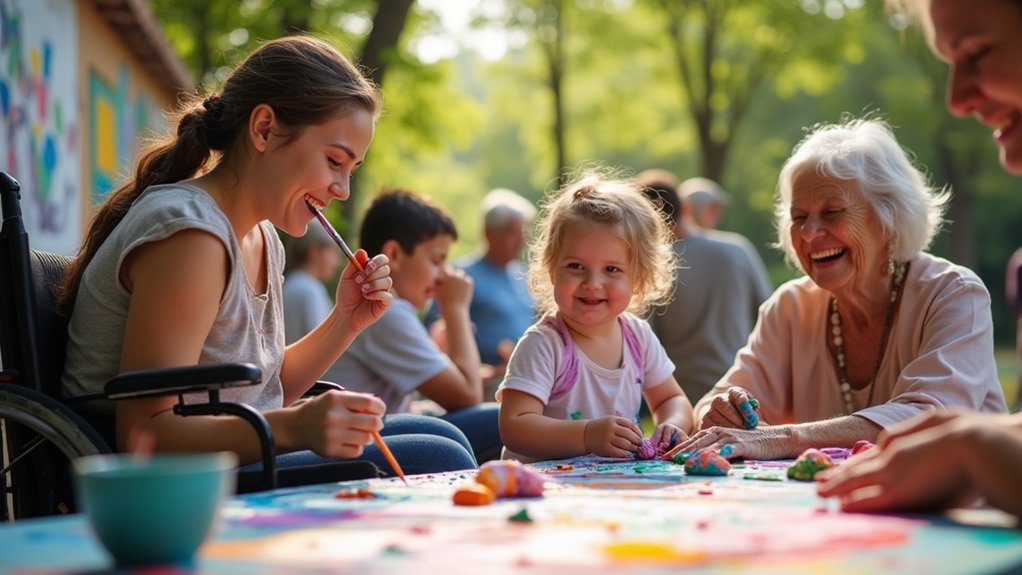
When communities embrace arts programs designed for all abilities, they create powerful spaces where diversity flourishes and social barriers diminish.
These inclusive initiatives help participants build self-confidence and emotional stability while fostering meaningful social connections.
You’ll find that neighborhoods with active arts programs see residents 1.6 times more likely to feel connected to their neighbors.
These programs highlight participants’ artistic capabilities rather than limitations, cultivating a sense of worth and community recognition.
The impact extends beyond personal development—inclusive arts programs drive economic growth, increase civic participation, and strengthen community cohesion.
Arts programming provides vital opportunities for youth to develop critical thinking skills through creative problem-solving and artistic expression.
Through partnerships with local organizations, these initiatives address social issues while ensuring equity in both content and form.
When art becomes accessible to everyone, communities don’t just create together—they thrive together.
The Healing Journey: Therapeutic Benefits of Adaptive Art
You’ll find remarkable healing in adaptive art as it mends trauma wounds through creative self-expression rather than verbal processing.
Your body’s limitations dissolve when you engage with adaptive art techniques designed specifically for your abilities, creating freedom through movement and imagination.
As you transform pain into visual or tactile expressions, you’re not just creating art—you’re rebuilding neural pathways and reclaiming your narrative through the therapeutic power of creativity. This process naturally decreases cortisol levels in your body, creating a physiological state of relaxation that complements the emotional release.
Art Heals Trauma Wounds
Trauma often leaves invisible wounds that traditional therapies struggle to heal, but adaptive art offers a powerful path to recovery. When you engage in expressive arts, you’re creating a non-verbal channel for emotions that might feel impossible to articulate.
Your healing journey benefits from art’s unique ability to visualize complex feelings, bypassing the limitations of language. You’ll find a safe space to explore traumatic memories without feeling overwhelmed, building resilience with each creative session. This approach provides an alternative to immediately verbalizing your emotional pain.
The multisensory engagement—combining movement, sound, and visual elements—enhances your processing of difficult experiences.
Studies consistently show that participants rate art therapy highly for treatment satisfaction, with many expressing a desire to continue long after formal therapy ends. Through adaptive techniques tailored to your abilities, you’ll discover that art doesn’t just express trauma—it transforms it.
Movement Beyond Physical Limitations
Despite physical constraints, the human body’s capacity for artistic expression transcends visible limitations. You’ll discover adaptive techniques that make dance and movement accessible regardless of mobility challenges, ensuring your safety while revealing new forms of expression.
When you engage in therapeutic movement, you’re not just improving flexibility and strength—you’re developing neurological pathways that enhance cognitive function. These adaptive arts offer you pathways to communicate emotions without relying on verbal skills, creating profound opportunities for self-expression. Sculpting activities particularly benefit visually-impaired individuals by stimulating other senses.
Through modified dance and specialized tools, you can participate in collaborative environments that foster community connection.
Whether rehabilitating from an injury or managing chronic pain, movement-based therapies provide both physical benefits and emotional release, proving that artistic expression isn’t defined by physical ability but by creative spirit.
Creative Expression Transforms Pain
When pain becomes a constant companion in your life, creative expression offers more than just a temporary escape—it becomes a transformative healing journey. Art therapy shifts your focus while actually modulating emotions tied to pain perception, not merely distracting you. A significant study in February 2018 demonstrated that art therapy improved moods and reduced pain and anxiety levels in hospitalized patients.
| Art Therapy Approach | Benefits |
|---|---|
| Visual arts creation | Reduces anxiety, depression; improves mood stability |
| Passive art viewing | Decreases emotional suffering; provides psychological relief |
| Spontaneous art-making | Enhances quality of life; creates “escape” experiences |
Research consistently shows that engaging in creative processes helps you regulate emotions, develop self-awareness, and improve interpersonal dynamics. Whether you’re painting, sculpting, or simply viewing art, these practices foster emotional expression that directly alleviates psychological distress that intensifies pain perception. You’ll discover new pathways to healing that medication alone cannot provide.
Breaking Barriers: Success Stories in Accessible Arts
As pioneers push the boundaries of inclusive expression, success stories in accessible arts have blossomed across institutions and individual practices alike.
The NEA’s four-decade commitment has catalyzed significant progress through nationwide convenings and policy dialogues that reduce employment barriers for disabled artists.
You’ll find tangible results in programs like Accessible Arts’ 2023 initiatives, which supported over 2,200 practitioners with disabilities through internships and mentorships. Their hybrid events earned 95.3% excellence ratings from audiences, demonstrating demand for inclusive formats.
The impact extends beyond individual careers—casting actors with disabilities attracts new audiences, while growing public appetite for diverse perspectives drives institutional change.
Though challenges persist, major venues increasingly prioritize work by disabled artists, gradually transforming cultural landscapes.
Frequently Asked Questions
How Do I Fund Adaptive Art Supplies for My Organization?
You can fund adaptive art supplies by applying to NEA grants, state arts agencies, foundations like Mellon or Kresge, or exploring ADAP programs. Consider community development funds and accessibility-focused non-profits too.
Can Expressive Arts Benefit Individuals With Communication Disorders?
Yes, expressive arts greatly benefit you if you have communication disorders. They’ll help you express emotions non-verbally, improve your psychological wellbeing, enhance your social skills, and provide alternative ways to connect with others.
What Qualifications Do Inclusive Arts Program Facilitators Need?
You’ll need education in relevant fields, experience with diverse groups, strong communication skills, cultural competence, and adaptability. Don’t forget interpersonal skills, creativity, collaboration ability, technical proficiency, and a willingness to be flexible.
How Can Families Continue Expressive Arts Practice at Home?
You can continue arts at home by setting up simple materials, creating a dedicated space, establishing regular art time, using household items for projects, and adapting activities to match family members’ interests and abilities.
Are There Virtual Communities for Disabled Artists to Showcase Work?
Yes, you’ll find robust virtual communities for disabled artists at platforms like LAB (Kinetic Light), Disability Arts Online, “Artists With Disabilities Showcase,” Tangled Art + Disability, and lutte, all offering exhibition and connection opportunities.
In Summary
You’ve discovered that art knows no physical boundaries. By embracing adaptive tools, movement-based activities, sensory experiences, and digital platforms, you’re part of a growing inclusive creative community. Whether you’re creating for therapy or personal expression, your unique perspective enriches the artistic landscape. Remember, it’s not about what your body can’t do—it’s about how your creativity can and will flourish.

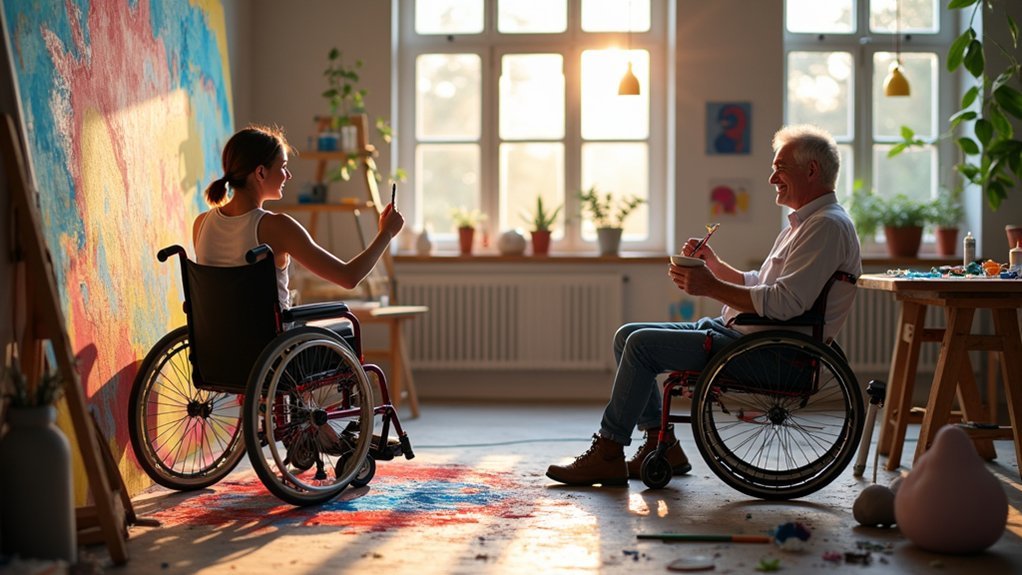



Leave a Reply